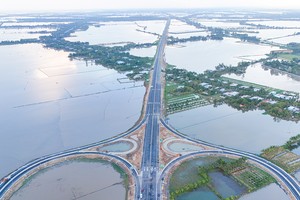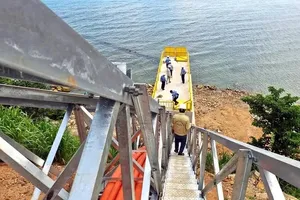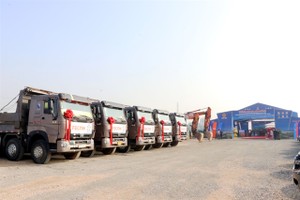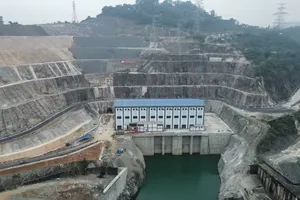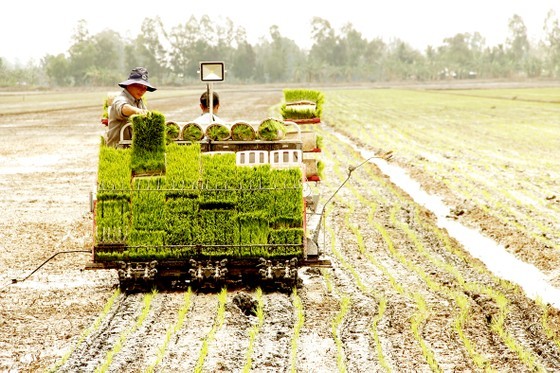 |
Farmers in Hau Giang Province are sowing their rice seeds for the winter-spring crop earlier to stay away from drought and salinity intrusion (Photo: SGGP) |
The National Center for Hydrometeorological Forecasting informed that El Nino has officially begun and will reach its peak after 3 months, with 56 percent of seeing a strong intensity and 84 percent of an average one.
Expert on ecosystems in the Mekong Delta Nguyen Huu Thien warned that farmers in Long Xuyen Quadrangle and Dong Thap Muoi areas should be cautious when investing in the next crop, while fishermen should take weather into consideration when buying new equipment for their trips.
Based on the report of the National Center for Hydrometeorological Forecasting, many localities in the Mekong Delta are urgently preparing scenarios to cope with El Nino.
Deputy Director Tran Cong Danh of the Kien Giang Province Agriculture and Rural Development Department said that his organization has just advised the provincial People’s Committee on plans to fight against El Nino in the 2023-2025 period on the same scale as the historic drought in 2015-2016.
Clean water supply is ensured for residents in the cities of Rach Gia, Ha Tien, Kien Luong as well as the islands of Phu Quoc, Kien Hai and remote areas. Drastic solutions are to be applied in locations directly affected by El Nino like the coastal area from Rach Gia to Ha Tien, the riverside area of Cai Lon – Cai Be, the districts of An Bien, An Minh, Vinh Thuan, and U Minh Thuong.
The Deputy Director stated that the most practical measure right now is to operate the sluice systems on Cai Lon – Cai Be Rivers to stop salinity intrusion into Cai San Canal and Rach Gia-Long Xuyen Canal; to store sufficient freshwater in the reservoirs of Ta Tay, Thanh, Vinh Thong, and Nam Rach Gia. Water should also be stored in the island City of Phu Quoc and the island District of Kien Hai. The reservoirs in the Nam Du Archipelago should be completed soon to store water.
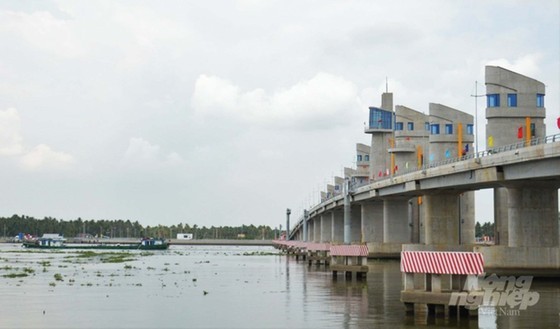 |
The operation of the two sluices of Cai Lon – Cai Be is a top priority to stop salinity intrusion in the Mekong Delta (Photo: SGGP) |
Director Nguyen Thanh Truyen of the Long An Province Agriculture and Rural Development Department stated that besides adjusting the time to sow the 2023 winter-spring crop, the district is consulting the provincial People’s Committee to actively fight against possible droughts and salinity intrusion as a negative impact of El Nino in order to protect the freshwater source for agricultural and daily activities.
Statistics from this Department show that the salinity intrusion and drought in the 2015-2016 period damaged over 10,000ha of crops, mostly rice fields (9,294ha), orchards (610ha).
Therefore, this time, the agricultural agency in the province is holding training sessions for farmers to apply advanced technical measures learnt from developed countries to save water in their work. The Department also suggests that farmers switch to trees that can better stand droughts in areas where the water source is scarce. Construction projects for irrigation works, especially in locations highly susceptible to water shortage or salinity intrusion, are directed to accelerate and put into operation.
Le Thanh Phong from the coastal Commune of Bach Dong in Thoi Binh District of Ca Mau Province shared that his family is taking advantage of the rain lately to wash away the salinity from his shrimp lakes and prepare for the next season. He is also following weather updates from the media to sow rice seeds for his next crop and avoid possible drought at the end of that crop.
Ca Mau Province is planning to sow seeds on over 35,000ha of rice fields for the winter-spring crop. According to the Ca Mau Provincial Hydrometeorological Station, the 2023 rainy season is likely to end early, leading to harsher salinity intrusion. Hence, the Agriculture and Rural Development Department of Ca Mau Province has actively adjusted the planting plan accordingly, reducing the crop time by 10-15 days compared to the previous one by switching to the seeds with shorter growing time and high yield.
Other places in the Mekong Delta are reminding local farmers to regularly update weather forecasts and warnings against negative influences of El Nino. Particularly, fruit farmers are advised to store sufficient freshwater in ponds and ditches for watering their orchards. Embankments and sluice systems should be maintained frequently to stop salinity intrusion. Pumping stations should be repaired or upgraded to be well prepared for the winter-spring crop.
Expert Nguyen Huu Thien predicted that in the dry season of 2024, the coastal areas in the Mekong Delta are at a high risk of drought and salinity intrusion owing to extreme El Nino. In particular, the Ca Mau Peninsula might have almost no freshwater supply from the Hau and Tien river systems, making drought and salinity more serious.







